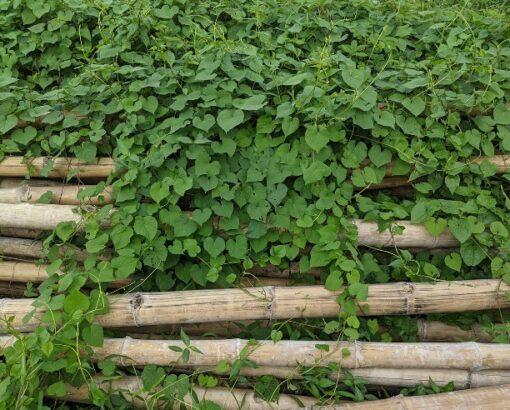
Over the years, pesky or latent issues such as radon, asbestos, lead paint, pyrrhotite and many more have sprouted up in community associations. The latest novel topic that community associations will have to address could be right in your backyard as an invasive species, Japanese Knotweed (Falllopia japonica or Polygon cuspidatum), is tangling its way through various parts of the United States, which has resulted in expensive treatment plans and legal battles. Naturally, the Japanese knotweed is likely to rear its head in community associations in the event where developers fail to eradicate Japanese knotweed presence prior to turnover and because it could affect shared common areas where there are many adjoining/abutting units.
Dangerous Invasive Species
Japanese knotweed is listed as one of the 100 worst invasive species globally. It is not poisonous but is dangerous because it can exploit weak areas in structures/roadways if left unchecked. The underground rhizomes can invade small cracks and cause damage to hard surfaces, block drains, and worsen cracks in building infrastructure. The extensive root system can grow 10’ deep and laterally over 20’ from the nearest stalk. Thus, Japanese knotweed treatment can be challenging because it is uncommon during the winter months and even if a small piece of the Japanese knotweed is left behind or spread in other areas, it can regrow.
Due to the unknowns and evasiveness of Japanese knotweed, there has been a ‘chilling effect’ reaction. In the U.K., the mere presence of Japanese knotweed has resulted in devaluation in property values, and if Japanese knotweed is found mortgages/insurance are often automatically rejected.
As to treatment plans, this varies from excavation, to continuous cutting, and/or herbicide treatment but is largely a case-by-case plan and requires an invasive species expert rather than simple landscaping. Not only are treatment and management plans meticulous, but they can be costly, take years to eradicate, and it may be difficult to determine who should bear responsibility.
Litigation and Expensive Verdicts
In both the U.K. and U.S., there has been litigation and expensive verdicts. In the case of Ryb v. Conway Chartered Surveyors & Ors [unreported case] in the U.K., it was determined that an inspector/surveyor was liable for negligence who failed to identify Japanese knotweed. In Network Rail Infrastructure Ltd. v. Williams & Anor in the U.K., the court held the defendants liable for nuisance. In that case, the Japanese knotweed at issue did not actually encroach on the claimant’s land but the court decided that the presence of Japanese knotweed amounted to a continuing nuisance and damage. The court reasoned that, even though the defendants had maintained the land for 50 years and were not responsible for the introduction of the invasive species, they stopped treating it which resulted in an undesirable element in close proximity to the claimants’ property that constituted actionable harm (the diminution in value of the property).
In the New York case of Inman v. Scarsdale Shopping Center Associates, LLC, the court entered a judgment of $535,000.00 for the plaintiff who claimed the defendants’ shopping center’s premises allowed Japanese knotweed to grow and damage plaintiffs’ grounds and residence even though there was no evidence indicating when and how Japanese knotweed first appeared on defendant’s property and even though defendant did not plant the knotweed. In Massachusetts in Trites v. Cricones, where attorney John Mateus of Woburn represents the plaintiffs, the trial court entered a $186,000 verdict for Trites where a developer made an ill-fated decision when instructing their contractor to mix knotweed-contaminated loam with clean loam throughout the subdivision.
Conservation commissions and municipalities are also responding. In 2021, Swampscott launched an identification and treatment initiative. Massachusetts towns like Concord, Natick, Weston, Brookline, and more are also establishing plans, while instances of Japanese knotweed have also sprouted in towns like Easton and Franklin Massachusetts. The Massachusetts Wetlands Protection Act and Massachusetts Conservation Commission Act (M.G.L. Chap. 40, sec. 8C) focus on the promotion, development, and maintenance of natural resources/open space so it is also important for homeowners to protect against Japanese knotweed from encroaching on public areas, as well as neighbors.
The U.K., who has incorporated an aggressive treatment approach, estimates that it has cost £166 million a year to control and clear Japanese knotweed. In addition, more than 5% of U.K. homes are reportedly impacted by it, which is estimated to decrease each property’s value by 10%, which averages £23,530 and would result in a nationwide issue costing £34.12 billion.
Addressing Japanese Knotweed
In associations, the Japanese knotweed issue can be particularly disconcerting where it could sprawl over large portions of common areas (for purposes of this article we will assume the Japanese knotweed stems from common area locations). So how should associations and property managers deal with Japanese knotweed?
In the event the developer turned over the property recently, the association may be able to seek recourse against the developer, contractor, and/or inspector.
However, assuming turnover occurred outside of your jurisdiction’s statute of limitation/repose timeframe, then association’s affected by Japanese knotweed should consider some best practices:
- Amend Governing Documents to prevent introduction of Japanese knotweed in communities
- Respect Property Rights and ensure compatibility with Sustainable Environmental Practices
- Consider Invasive Species Expert (not just a landscaper) who can determine if excavation, remediation treatment, or herbicide is most appropriate
- Look into Legislation and/or Government Assistance Programs
- Follow State and Federal Guidelines as they develop, especially related to responsibility for maintenance and disclosure requirements
- Engage with local Conservation Commissions
- Utilize Distribution Projection Maps or Street Images during out-of-season Inspections
- Collaborate with Unit Owners to provide notice and to develop sustainable, consensus-driven decisions
Jake E. Marcus, Esq. is a partner with the law firm Allcock & Marcus, LLC and Stephen Marcus, Esq., CCAL is an attorney of counsel with the firm.

